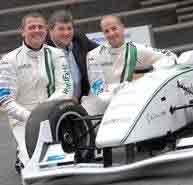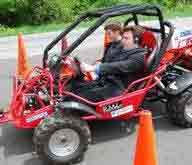VOICE ONE:
This is SCIENCE IN THE NEWS in VOA Special English. I'm Bob Doughty.
VOICE TWO:
And I'm Faith Lapidus. Today, we will tell about a genetic map of one of the world's major food crops. We will tell about a car made mostly from renewable materials, like plants. And, we will tell about an experimental vehicle designed for blind drivers.
(MUSIC)
VOICE ONE:
Scientists have released a genetic map of the potato. The map is the work of scientists from 14 countries. The project is called the Potato Genome Sequencing Consortium.
Potatoes are one of the world's leading food crops. Breeders currently spend 10 to 12 years developing new kinds of potatoes. Now they will be able to identify genes for any desired trait, improving quality, nutritional value and disease resistance.
A genome contains information about every position alongchromosomes, the structures that hold genes. Genes direct the making of proteins which do much of the work in building an organism, whether a person or a potato.
A potato has 12 chromosomes and about 840 million base pairs. This is about one-fourth the size of the human genome.

VOICE TWO:
The potato genome shows the order of 95 percent of the genetic material. Most potato varieties carry four separate copies of their genes. But the researchers did much of their work with a phureja -- a kind of a potato that has only one copy. Richard Veilleux provided that variety of potato. He is a professor with the Virginia Polytechnic Institute and State University.
Plant biologist Robin Buell of Michigan State University also worked on the genome. She says it will improve understanding of other crops because potatoes have been linked to tomatoes, peppers and eggplants.
VOICE ONE:
Separately, another team reported completing a genome of the organism responsible for late blight. That disease can infect potatoes, tomatoes and other plants. It causes several billion dollars a year in agricultural losses.
Late blight was also the cause of the potato famine in Ireland in the middle of the 1800s. Potato shortages were blamed for at least one million deaths. The food shortages were responsible for many Irish immigrants moving to the United States.
VOICE TWO:
The scientists say that studies based on the new genome may help explain, in the short-term, why the organism has been so aggressive. And, in the long term, they say, knowing where different genetic traits may be found on the map could lead to better plants. It could also reduce the need for chemicals.
Completion of the project was reported in the journal Nature. Researchers at Harvard University and the Massachusetts Institute of Technology led the work.
(MUSIC)
VOICE ONE:
Researchers in Britain are driving the environmental movement to a whole new level. A team from the University of Warwick has built what it calls the world's first completely environmentally friendly Formula Three racing car.
The car is made mainly of sustainable and renewable materials, like plants and vegetables. The structure around the car is made from natural plant fibers and potatoes. The steering wheel is made from root vegetables like carrots. The engine uses biofuel made from vegetable oil and waste chocolate.
VOICE TWO:

The new race car is extremely fast. The car has a top speed of 215 kilometers an hour. And it can go from zero to 95 kilometers an hour in just two and one half seconds. The race car meets all of the Formula Three racing requirements except for its biodiesel engine.
The car resulted from the efforts of the University of Warwick's Manufacturing Group and the Warwick Innovative Manufacturing Research Center. They developed the car because of criticism of the racing industry.
VOICE ONE:
Automobile racing is one of the most widely watched sports in the world. But it also is considered one of the least friendly to the environment. Race cars burn a lot of fuel, and create a lot of air pollution.
In recent years, the racing industry has taken steps to protect the environment. More racing companies are now producing cars that use less energy. These cars produce less pollution than vehicles that depend on traditional fuels, like gasoline.
VOICE TWO:
Last year, two American government agencies and an international organization announced a number of policies for environmentally-friendly racing. They are known as the Green Racing Protocols.
The two agencies are the United States Department of Energy and the Environmental Protection Agency. The organization SAE International represents engineers and technical experts in the transportation industry. Officials from the American Le Mans Series also were involved in the effort.
The American Le Mans Series became the first racing event to use the protocols in its Green Challenge competition. The race was held in October of last year.
VOICE ONE:
Last month, the WorldFirst Formula Three racing car was set to run in its first competitive race at the Formula Three Championship Final at Brands Hatch. It would have been the first biodiesel-powered car to race at Formula Three.
Current Formula Three rules let only gasoline-powered cars compete. Officials needed permission from all of the other Formula Three racers for the biodiesel WorldFirst car to compete. They were unable to contact one of the drivers, so the WorldFirst car was barred from the event.
In test runs, the WorldFirst car was the fifth fastest among Formula Three race cars. Supporters are hoping to have the fuel issue resolved in time to compete next season.
(SOUND)
VOICE TWO:
That recording is from the 1992 movie "Scent of a Woman." In the film, a blind man, Frank Slade, takes another man, Charlie Simms, for a fast ride in a Ferrari through the streets of New York City. Charlie gave the directions while Frank was the driver. For the blind Frank, it was one of the most exciting things he had ever done.
Recently, several Americans who are blind experienced a similar thrill. It took place in a restricted driving area at the University of Maryland, near Washington, DC. This time, no co-pilots were required. The car provided directions to the blind drivers.
VOICE ONE:

Students from Virginia Tech's Robotics and Mechanisms Laboratory designed the Blind Driver Challenge car. The Virginia Tech team put a laser sensor on the front of the car to look for activity in nearby areas. The device sends a signal to a computer at the back of the car. The computer then takes the signal and gives the driver spoken directions on how to drive the car to avoid an accident.
For example, it might say, "Go straight. Now turn two clicks to the right. And now, turn five clicks to the left." The driver follows the directions and makes turns based on sounds that the steering wheel makes when it is turned.
VOICE TWO:
A special vibrating vest worn by the driver provides information about the vehicle's speed. There are also sensing devices that stop the engine if the vehicle gets too close to anything.
On test day, all the blind drivers were able to guide the car through the test area without any problems.
The first blind drivers to test the car were employees from the National Federation of the Blind. One of the drivers found the car's directions to be more exact and dependable than those from a human passenger. The Virginia Tech team said the blind drivers performed better than sighted drivers who carried out the tests with their eyes covered.
Team members say the new car is the first and only one that gives the blind person complete control of the vehicle. The team members are excited about the project's success. They say the new technology offers many possibilities for other projects to help the blind.
(MUSIC)
VOICE ONE:
This SCIENCE IN THE NEWS was written by June Simms and Jerilyn Watson. Our producer was Brianna Blake. I'm Bob Doughty.
VOICE TWO:
And I'm Faith Lapidus. Join us again next week for more news about science in Special English on the Voice of America.
consortium: an association or society 聯盟
chromosome: a circular strand of DNA in bacteria that contains the hereditary information necessary for cell life 染色體
biodiesel: a biofuel intended for use in diesel engines 生物柴油
protocol: a code of correct conduct 規則
Related stories:
Learning the secrets of the potato, and an enemy
DIY: Growing potatoes
A cycle rickshaw with help from the sun
Indian launches world’s lowest-priced car
(Source: VOA 英語點津編輯)